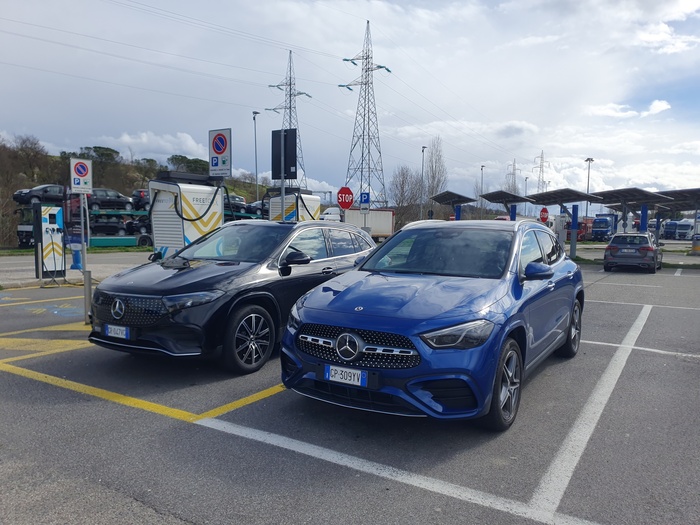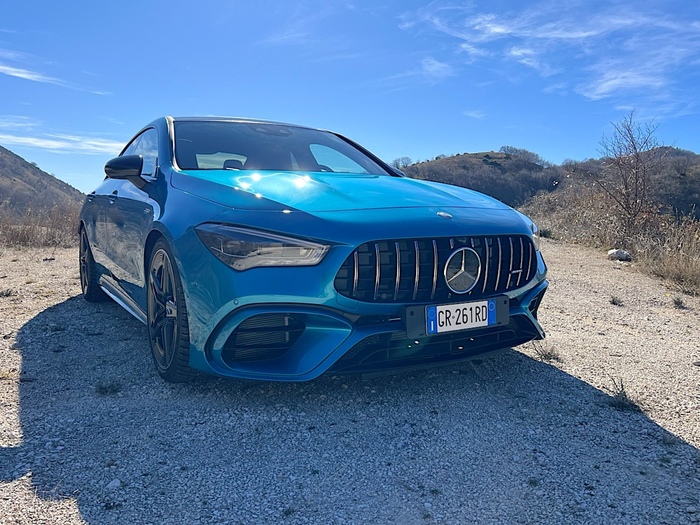Icon: enlarge
During the test drive, we drove a prototype of the compact electric car Mercedes EQA, which was still slightly camouflaged.
Photo: Daimler
The first impression:
SUV meets smartphone.
With the closed black plastic grill, the front of the EQA is reminiscent of the front of the iPhone.
This makes the electric version look a little fresher than the rest of the model family.
What the manufacturer says:
For Mercedes head of development Markus Schäfer, the new EQA is a tailor-made electric car, but it is also a compromise.
How should that fit together?
Schäfer explains it like this: Tailor-made, because there will be numerous variants with different levels of power, traction or range.
The car is a compromise because it does not use its own electrical architecture like the battery-powered cars from the VW Group or from Kia and Hyundai.
Instead, the modular front-wheel drive architecture (MFA) is used, which is also found in the conventional twin GLA, in the A-Class and in other compact Mercedes models.
Mercedes is thus following the path taken by BMW with the iX3 or the Stellantis Group with models such as the Peugeot 208e or the Opel Mokka E. The advantage of this, according to Schäfer: With the concept, Mercedes is able to produce a powerful vehicle at comparatively low costs Bringing the market - in a relatively short time.
However, VW has already launched the ID.4 in the same segment, developed on an electric platform.
The car can do more and cost less.
Apparently they have now also recognized the advantages of electric platforms in Stuttgart: The EQS, the “electric S-Class”, will be the first Mercedes to use a modular system specially developed for electric drives.
However, it won't come until autumn.
We noticed that:
silence.
In this category, the EQA also stands out from many other e-cars.
Project manager Jochen Eck used the ample space in the bow, which is otherwise necessary for diesel or gasoline units, to store the electric engine in a complex way.
It rests in a kind of double subframe and is thus better decoupled from the body than is the case with its competitors.
The result is a level of calm that no other electric car offers in this class: Not only do no noises from the engine compartment penetrate the interior, but also no vibrations.
This saves the driver that tram feeling that other battery-powered cars sometimes get on the nerves of.
And that's just one point where the EQA is more consistent than some vehicles that are built with a special electric car architecture.
When it comes to energy recovery, Mercedes goes further than VW does with the ID models.
The Swabians have programmed five recuperation levels.
In the most powerful, they draw off so much power via the reversed electric motor that the conventional brake is actually superfluous.
If the driver lifts his foot, it even presses him lightly into the seat belt.
Inside, the EQA is a twin of the GLA - unfortunately.
The space available, especially in the rear, is not nearly as generous as in an ID model from VW, but much better than in the Opel Mokka-E, for example.
With a capacity of 340 to 1320 liters, the trunk is as large as in the GLA;
however, the incline of the rear seat cannot be adjusted.
The rose-gold applications that Mercedes head of design Gordon Wagener made the hallmark of the EQ models are also available in the EQA - but only at an additional cost.
It is worth taking a look at the infotainment system with its EQ features.
The navigation system suggests routes depending on the weather and topography in order to achieve the maximum range.
The route leads past charging stations, the necessary charging breaks are included in the travel time.
You have to know that
: Mercedes has been taking orders for the EQA for a few days, the base price is 47,541 euros.
Deliveries should start in a few weeks.
It starts with the 250 model, which has an output of 140 kW (190 PS) and has a battery capacity of almost 67 kWh and has a standard range of 426 kilometers in the WLTP cycle.
With up to 375 Nm, it accelerates from standstill to 100 km / h in 8.9 seconds and is limited to 160 km / h with regard to the range of action.
Charging is done with up to 100 kW, so it takes about 30 minutes on the DC column until an empty battery is back to 80 percent.
A version with all-wheel drive, two engines and more than 200 kW (272 hp) is to come soon, as well as a variant with a range of more than 500 kilometers.
The technology from the EQA will be transferred to the GLB this year, which will then become the EQB.
We won't forget that: the way
it shimmers in color in the console in front of the passenger.
This lighting is not unique, but it looks good and fits the electrical ambience.
Thomas Geiger is a freelance writer and was supported in his research by Mercedes. Reporting is independent of this.
Icon: The mirror







